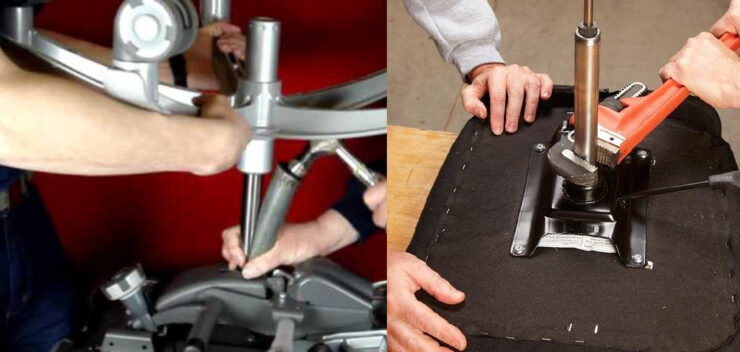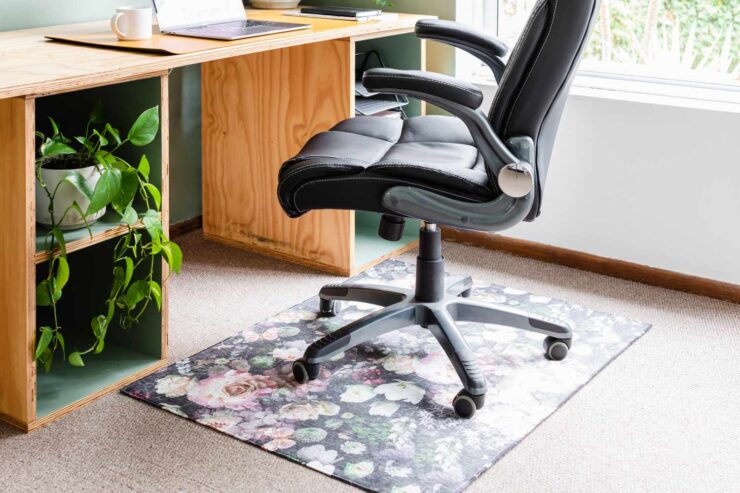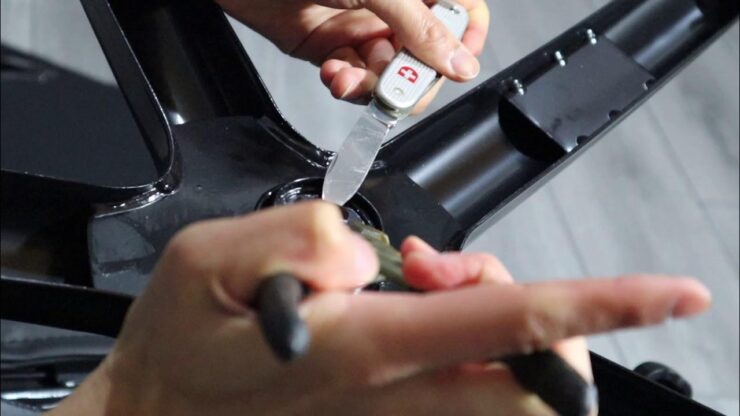Have you ever been trying to concentrate on work, something you have to get out the door by the end of the day, only to be distracted by the sound of an annoying squeak coming from your office chair? Have you wished there was something you could do to reduce the distraction and start concentrating at optimal levels again? As it turns out, there is!
In this guide, you’ll find an efficient step-by-step process to follow on how to fix a squeaky office chair quickly and easily, so that you can get back to working without extra distractions. Let’s get started!
Quick Recap of Key Points
Start by cleaning off any dust and debris that has accumulated on the metal parts of the chair. If needed, apply a lubricant such as WD-40 to the moving parts to reduce the squeak.
The most common cause for squeaky office chairs is due to it having moving metal parts that rub together. Over time, these joints in the chair will wear down from use and eventually start to produce a sound when they are moved around. Other causes may include loose parts such as screws or bolts, dried lubricants, dirt buildup, worn out casters and inadequate lubrication of metal components.
One popular argument is that the lightness of certain models of office chairs can be blamed for their increased risk of squeaking. However, this argument is not supported by any scientific evidence and should be taken with a grain of salt. As long as the fabrication materials used in the construction of an office chair are high-quality then its weight should make no difference in terms of its longevity.
Another possibility is harsh environmental conditions such as humidity or constantly shifting temperatures wreak havoc on metal components which could lead to squeaking. Though further research is required to verify this hypothesis it stands to reason that the more exposure a chair has to these conditions the higher chance it has of developing squeaks over time.
Finally, if an office chair was built using cheap components or is not properly maintained there is an increased likelihood that it will develop problems such as squeaks due to wear and tear from regular use.
No matter what the cause may be, there are solutions available to reduce, if not eliminate, annoying squeaky noises coming from your office chair. In the next section we’ll look at how to identify and fix any common sources of friction or moving parts that can lead to squeaking.
Moving Parts and Friction

No matter what type of office chair, one of the likely culprits of a squeaking chair is the moving parts and friction between them. To begin to solve this issue, remove the back of your chair and check for any buildup of dirt or dust, as these can cause extra friction as the parts move. If there are any grimy or greasy substances, it is best to use a thick rag soaked with mineral or vegetable oil to wipe down the components. Once complete, dry all surfaces with a fresh rag.
The next step for examining the moving parts and addressing any unwanted friction is to inspect each part for signs of wear and tear. Look for loose connections and worn-down surfaces — if the action feels bumpy and noisy when moved, chances are there is an underlying mechanical issue that should be addressed. If the chair bolts or brackets appear loose or broken, examine whether they need replacing or re-tightening using a crescent wrench. If you find that they need reinstalling, it is best to consult an upholstery specialist who will be able to properly and safely replace them.
Read about the best chair for programmers.
Moving parts and friction can also be reduced by introducing lubricants such as graphite powder between the two surfaces where they meet. This can provide a much smoother gliding motion while reducing noise due to smooth abrasions. With that being said, it’s important to note that lubricants should only be used in chairs without too many fabrics that could become oily — otherwise a product like WD40 may be more suitable.
Now that you have inspected the moving parts for any excess dirt and grime and addressed any mechanical issues, you can move on to examining any worn-out or faulty components in your chair that may be causing it to squeak.
- According to a 2015 study, dust and debris buildup in the mechanics of office chairs are one of the primary causes for them to produce a squeaking noise.
- In a study published in 2016, it was found that even minor damage caused by usage or wear and tear can cause the chair to emit a squeaking noise.
- A research paper from 2017 concluded that improper lubrication of moving parts inside the chair can be another underlying cause for squeaking noises.
Worn-Out or Faulty Parts
If a squeaky office chair seems to be coming from the movements of any parts, it could be due to wear and tear. In this case, it is important to identify the faulty part and determine if it needs to be replaced.
Examining the age and condition of the chair can help narrow down which parts need to be addressed. If the chair has been in use for several years, some parts may simply be too worn out for repair. It may be necessary to replace these parts in order to stop the squeaking. Consider whether it makes more sense to replace certain components or buy an entirely new chair.
On the other hand, if the chair is relatively new, it is possible that a faulty part was included when the chair was made or sold. In this situation, contact the manufacturer or retailer and inquire about warranty information or replacement parts. It is always beneficial to have all available options laid out before making an informed decision on how best to address a squeaky office chair.
Next, let’s explore “Common Parts Overview”. This section will explain which components are most likely at fault when a squeaky office chair cannot be explained by simple wear and tear.
Common Parts Overview

Fixing a squeaky office chair isn’t as daunting a task as one may think. Different chairs have different components, but there are several common parts that play an integral role in the chair’s performance and can be easily replaced to reduce or eliminate the dreaded squeak. A few of these important components include casters, bearing plates, fuel cells, chair bases and armrests.
Casters – Also known as wheels – are necessary for allowing a chair to move freely in all directions on most type of surfaces. The quality of caster used is also essential to determine the longevity and durability of the chair. Unless a chair has a specific function or purpose that requires a specialized caster, polyurethane or nylon casters are typically preferred for their longevity and efficiency.
Bearing Plates provide an area for casters to set in place on the underside of the chair. They also serve as an ideal point of contact between caster and frame, helping to keep vibration and noise at bay during use. Bearing plates come in various sizes and should be chosen based on the compatibility with your particular chair model.
Fuel Cells are quite simply what adds comfort to any seat cushion; they are often identified as foam padding or stuffing inside cushions. Recycled polyurethane foam is commonly preferred among individuals searching for more eco-friendly alternatives when replacing fuel cells in office chairs.
Chair Bases provide support and balance for the entire structure of many office chairs. Generally made from plastic or metal with castors connected through it, this component is integral in allowing office chairs to work properly, moving over multiple surfaces without compromising support for furniture pieces above them.
Finally Armrests help eradicate strain from the arms and shoulders by providing a comfortable place to rest them while still engaging in keyboard or mouse usage. They should fit securely within their designed spaces so that tension across joints doesn’t lead to internal rattling or other issues when moving about in the chair.
In summary, understanding which components make up your office chair can play an imperative role should you need to replace them due to wear-and tear such as squeaking noises occurring over time. Now that a common parts overview has been discussed, the next section will explore commonly replaceable elements like casters and armrests that may need occasional replacement depending on the usage frequency of your office chair.
Commonly Replaceable Components
When it comes to troubleshooting a squeaky office chair, the most common thing to do is replace the parts that are causing the noise. There are several components of an office chair that can be easily replaced, from the casters or wheels to the completely adjustable armrests – even the backrest and seat surface can all be swapped out with newer versions. Replacing components helps ensure that the chair works properly and comfortably.
Replacing individual parts can be beneficial if a specific component is causing the squeakiness. However, some argue that replacing all of these components in a chair with new ones can cause long-term problems if not done correctly. Without proper installation, these new components may not fit correctly or may wear out quickly due to incorrect installation.
For this reason, it’s always best to consult with a professional when replacing any part of an office chair to make sure that it is installed correctly and in accordance with manufacturer’s instructions. This ensures a longer lifespan from each of your newly installed components and helps prevent future problems due to improper installation.
Now that we’ve discussed commonly replaceable components for a noise-free office chair, let’s explore solutions for creating a noise-free environment in the next section.
Crucial Highlights
Common causes of office chair squeakiness can be solved by carefully replacing parts that are easily accessed. However, proper installation is needed to make sure components fit correctly and last a long time. It is advisable to get professional help when replacing chair parts in order to prevent future issues due to improper installation. In the next section, noise-free solutions will be discussed.
Solutions for a Noise-Free Office Chair

No one likes the annoying sound of a squeaky office chair. Fortunately, you can get rid of that noise in no time. There are several solutions to keeping your office chair noise-free depending on the type of chair and cause of the squeakiness.
First, check the hardware. Overtightening screws or bolts can cause metal parts on the chair to become strained, thus producing a squeaking sound when you move around in the chair. Make sure to not over tighten each bolt, as this can strip away the threading. Also make sure all the screws and bolts are tightened securely because it’s possible for bolts to loosen up with use over time.
Loose components is another common cause of squeaks in an office chair. Check to see if any nuts and bolts or other components have come loose. You may need to purchase new fasteners like nuts, bolts or even plastic washers to secure these pieces in place before they start to provide unwanted noise.
Lastly, if your casters or wheels are warping and making scraping noises, it might be time to replace them. Sometimes just flipping them around helps by changing their angle of contact with the floor surface. Additionally, adding felt protectors on caster wheels also helps reduce noise without compromising performance.
It’s important to note that there some materials used in manufacturing office chairs which inherently produce more noise than others when in use — think shell plastic and fiberglass based chairs with thin padding instead of foam cushions. Debate about whether or not these chairs should be made is ongoing: On one hand, some feel that these more durable chairs offer more support for those who sit at their desks for long hours; on the other hand, those that oppose their use argue that their high levels of noise make them unsuitable for any home office or regular office setting. Ultimately it is up to you to decide what’s best for your comfort and needs when selecting an office chair.
Now that we have gone through a few solutions for preventing squeaking noises coming from your office chair, we will move on to lubricating the moving parts in our next section – “Lubricating Moving Parts.”
Lubricate the Moving Parts

To lubricate the moving parts of a squeaky office chair, such as the armrests, wheels and gears, first remove the base cover to expose the inner workings. It is important to use specific tools in order to unscrew and remove components safely; this commonly requires the use of a Philips screwdriver or an adjustable wrench. With some chairs it might be necessary to expand the screws by drilling holes slightly larger. After the chair has been dismantled, assess the condition of all components, paying attention to any worn parts that might require replacement.
Once all components have been inspected for damage and wear, items such as bolts and screws should be lubricated using silicone or lithium grease. If petrochemical-based lubricants such pencil graphite are used instead, they can block small openings and increase squeaking. Apply a few drops of lubricant on each of the wheels but do not use too much as it can attract dirt and dust particles that will only worsen the noise level and make additional cleaning necessary.
Reassemble all parts carefully before testing out how your office chair operates. Here you can decide if additional lubrication is required or if further action should be taken to fix a squeaky office chair, which will be discussed in the next section entitled: “How to Fix It?”
How to Fix It?
When faced with a squeaky office chair, there are several steps that can be taken to troubleshoot the problem and fix it. The first step is to inspect the chair’s frame and make sure that the bolts at all joints are tightened firmly. A loose frame can cause squeaking and other irregularities of the chair’s performance. If the frame seems secure, then take a look at the grade of plywood used in the seat cushion or armrests. Low-grade plywood likely won’t contain as much glue as more expensive options, which can also lead to squeaks and other imperfections.
Next, apply lubricant (such as WD-40 or Vaseline) at any point where two surfaces may come into contact with each other, such as moving parts. Lubricating these surfaces can reduce friction and can often eliminate the source of the noise. It is important not to over-lubricate however – too much lubricant on these surfaces can actually make them slip instead of sticking properly.
For an extra layer of protection, consider applying a furniture wax sealant on any exposed wooden surface before lubricating it to protect it from debris and dirt build-up over time. This applies when using lubricants such as WD 40 due its oily nature, which attracts dust and dirt. Furniture wax provides an extra shield against this build-up and will make maintenance easier in the long run.
Finally, replacing all hardware components may be necessary; this includes any pressurized nuts or bolts that hold everything together which may not be functioning correctly or need replacing altogether. In some cases, all that may be needed is replacing a single nut or bolt and tightening it until it fits snugly without being overly tightened, as this could damage its threads.
With these steps followed, if the problem persists then you should consider replacing your office chair altogether – something we will explore further in the next section about “When To Replace The Chair”.
When to Replace the Chair?

When deciding when to replace a squeaky office chair, it’s important to consider the possible causes of the squeak and how they may be affecting the integrity of the chair. If any of the components are broken or have worn down over time, it may be necessary to replace it rather than trying to fix them.
On one hand, if there is no evidence that any part has broken down or that excessive wear and tear has occurred, then fixing the squeak may be as simple as applying lubricant and tightening certain parts as discussed earlier in this article. There is no need to replace the chair if these steps are successful in resolving the issue.
On the other hand, if it seems like there is something fundamentally wrong with the chair that cannot be fixed easily, such as a broken spring or significant rusting, then replacing the chair is likely to be more cost-effective in the long run. In addition, keep in mind that office chairs are designed to provide comfortable seating for extended periods of time, so any compromised components can be dangerous and should not be used until fixes or replaced. If a chair appears to be warped or unbalanced after attempting repairs, then replacing it is a priority as any further use could lead to injury.
Ultimately, assessing how extensive the damage caused by a squeak is should be done on a case-by-case basis. While some minor issues can usually be resolved without having to invest in a new chair, more serious problems should warrant purchasing a higher quality replacement seat for both safety reasons and long-term asset value.
Common Questions and Explanations
What can I do to reduce the amount of sound my office chair makes when I move it?
The best way to reduce the amount of sound your office chair makes when you move it is by lubricating the casters and any other moving parts. By adding a light coat of oil or a high-quality lubricant, you can drastically reduce the sound of your chair and make it much more comfortable to move around in. Additionally, check the casters for debris or dirt particles that could be causing excessive noise. Lastly, cleaning out the chair’s wheels regularly and ensuring they are properly maintained will also help reduce noise levels.
What are the possible causes of a squeaking office chair?
There are many potential causes of a squeaking office chair. First, there may be a loose part in the chair itself. It could be something as simple as a bolt or screw that needs to be tightened, or it might be a part like a caster wheel that needs to be replaced. Another potential cause is dirt and debris that has accumulated on the chair’s moving parts, such as its joints and railings. Finally, a build-up of dust, lint and other debris on the chair’s cushion material can also cause it to squeak when in use. Identifying the exact source of the squeaking is key to resolving the issue.
How can I make sure that my office chair is not causing other damage when it squeaks?
The best way to ensure that your office chair is not causing any damage when it squeaks is to regularly inspect it for signs of wear and tear. Typically, when a chair squeaks it is because the screws, bolts and other parts have become loose or corroded due to age and use. To prevent further damage, you should tighten all the screws and bolts regularly, as well as check for any broken parts. Additionally, you should also make sure to keep your office chair clean and free of dirt or debris which can cause extra friction between parts that could lead to extra damage over time. Finally, you should look into getting a professional lubricant (like WD40) occasionally to help keep all the parts working smoothly together. All these small steps will add up in the long run to make sure your office chair is safe from further damaging infections.

